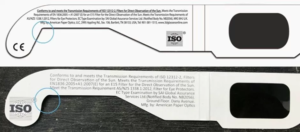On August 29, 2017, The Hannon Law Firm, LLC and co-counsel filed a class action against Amazon on behalf of people who purchased unsafe and hazardous Eclipse Glasses from their website before August 21, 2017. The case was filed in The US District Court for the District of South Carolina, Charleston Division.
On August 21, 2017, the entire United States was treated to a once-every-two generations event: a total eclipse of the sun by the Earth’s moon. Such events are known as Solar Eclipses. During a Solar Eclipse, the moon moves between the sun and the Earth. When the orbital planes of both the sun and the moon are identical, the moon casts a shadow onto the Earth.
During a TSE, the moon actually casts two shadows on the Earth. The first shadow is known as the “umbra” and is the dark center of the moon’s shadow, which gets smaller as it reaches Earth. The second shadow is known as the “penumbra” which gets larger as it reaches Earth. People standing in the penumbra will see a partial eclipse, while those standing in the umbra will see a total eclipse, also known as a “Totality.” Serious eye injury can occur when people view either partial or total solar eclipses without adequate protective eye-wear.
The lawsuit claims Amazon knew, or should have known, the eclipse glasses were hazardous and did not meet ISO specifications. Plaintiffs seek damages and injunctive relief arising from Amazon’s violations of South Carolina law, as well as analogous common and products liability protection laws in each state in which Amazon operates.
Payne v. Amazon Class Action Complaint
Amazon’s Email Recall Was Tragically Too Little, Too Late
Amazon’s August 19, 2017 email notification was insufficient to timely appraise customers of the defective nature of their glasses, and resulted in Plaintiffs and members of the proposed class using defective Eclipse Glasses to view the 2017 TSE.
Many Eclipse Glasses sold by Amazon were sold in packs of 3 to 20, and distributed to individuals, who never received a warning email.
Plaintiffs dispute the adequacy, timeliness, and efficacy of any and all refund and/or recall efforts implemented by Amazon.
Possible Injuries from Viewing 2017 TSE with Non-Compliant Solar Eclipse Glasses
The American Academy of Ophthalmology (“AAO”) states unequivocally that looking directly at the sun can seriously damage your eyes. The AAO admonishes that “[s]taring at the sun for even a short time without wearing the right eye protection can damage your retina permanently.” Even short exposures can cause vision impairment, up to and including blindness, which is known as solar retinopathy. Symptoms of solar retinopathy typically show up approximately 12 hours after the viewing event, and can include the following symptoms:
- Blurry vision
- A central blind spot in one or both eyes
- Increased sensitivity to light
- Distorted vision
- Changes in perception of color
Short term issues arising from unprotected or improperly protected direct Solar Eclipse watching can include “solar keratitis” which is similar to sunburn of the cornea (the front part of the eye) and can cause eye pain and light sensitivity, with symptoms often occurring within 24 hours after exposure.
The AAO warns on its website that the safe way to look directly at the sun is through special purpose solar filters. These solar purpose filters are used in Eclipse Glasses,” and must meet a stringent worldwide standard known as ISO 12312-2. Commercially available sunglasses, even with darkest and polarized lenses, do not meet ISO 12312-2 requirements and are not safe for viewing Solar Eclipses.
How Can I Tell if My Glasses Were Compliant?
The top pair of glasses are one example of ISO compliant glasses. The bottom pair of glasses are one example of glasses that are not compliant with the ISO standards.

